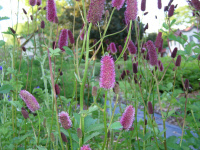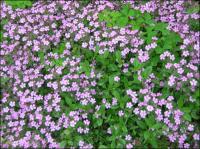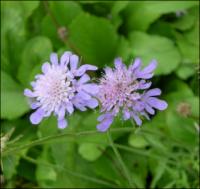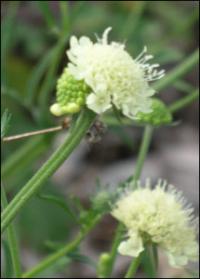Perennials & Biennials
Showing 417–424 of 511 results
-
Sanguisorba hakusanensis Korean burnet, Lilac squirrel Z 4 – 9
In mid to late summer bushy purplish-pink tails (like a Barbie doll squirrel tail) nod gracefully downward atop erect stems emerged from a clumping base that sprouts sage-colored, scalloped leaves.
OUT OF STOCK
In mid to late summer bushy purplish-pink tails (like a Barbie doll squirrel tail) nod gracefully downward atop erect stems emerged from a clumping base that sprouts sage-colored, scalloped leaves.
Size: 12-18”x12”
Care: sun to part shade in moist to moist well-drained soil
Native: Korea and JapanSanguisorba is Latin meaning to soak up blood, for the plant’s reputed ability to clot blood. Hakusanensis means coming from Haku, a mountain in Japan where this grows. Described in Botanical Magazine (Tokyo) in 1907.
-
Sanguisorba menziesii Menzies’ burnet Z 4-8
Wands of oval-shaped claret blooms in summer
Wands of oval-shaped claret blooms in summer
Size: 4' x 2'
Care: full sun to part shade in moist well-drained soil
Native: Alaska, Canada, Pacific NWSanguisorba is Latin meaning to soak up blood, for the plant’s reputed ability to clot blood. This species named for its collector Archibald Menzies (1754-1842), English physician on Vancouver’s voyage in 1792 who explored the Pacific Northwest, California, Alaska & Hawaii.
-
Sanguisorba obtusa Japanese burnet Z 4-9
A confection - neon Barbie-doll pink dangling bottle-brush spikes
OUT OF STOCK
A confection – neon Barbie-doll pink dangling bottle-brush spikes- spectacular- July – September
Size: 2-3’ x 2’
Care: moist to moist well-drained soil in sun
Native: Honschu Japan
Wildlife Value: attracts bees and butterfliesSanguisorba is Latin meaning “to soak up blood”, for the plant’s reputed ability to clot blood. This species collected before 1873.
-
Sanguisorba parviflora syn S tenuifolia var. parviflora, S. tenuifolia var. alba White Japanese burnet Z 4-8
Drooping white spikes (I know, drooping and spike are an oxymoron but you get the idea) atop tall stems and above narrow, dissected foliage. Blooming in July into October.
Drooping white spikes (I know, drooping and spike are an oxymoron but you get the idea) atop tall stems and above narrow, dissected foliage. Blooming in July into October.
Size: 3-5' x 18"
Care: Sun to part shade in moist well-drained soil
Native: Japan, Korea, Mongolia & Russia
Wildlife Value: attracts bees and butterfliesCollected by 1874. (Maxim.)
-
Santolina chamaecyparissus Lavender cotton , Cotton lavender Z 5-9
Grown for its ornamental grey foliage, yellow flowers in midsummer
Grown for its ornamental grey foliage, yellow flowers in midsummer
Size: 20” x 36”
Care: Full sun in well drained soil
Native: Mediterranean area
Awards: Recipient of the Royal Horticulture Society Award of MeritChamaecyparissus means dwarf cypruss to describe its appearance. Shrub grown in English and Italian flower gardens since 1500’s. Italians planted it with other shrubs to form mixed hedges. Grown in American colonial gardens since 1670’s.
-
Saponaria ocymoides Rock soapwort Z 4-9
Cheery pink soapwort, in late spring, hugs the ground
Cheery pink soapwort, in late spring, hugs the ground.
Size: 3" x 18"
Care: Sun, well-drained soil, cut back hard after flowering
Native: Spain to Yugoslavia
Awards: Received England’s Royal Horticultural Society Award of Merit.Both the botanical and common names come from the plant’s use as soap, the leaves “yeelde out of themselves a certain iuice when they are bruised, which scoureth almost as well as sope.” Gerard (1633). Soapwort is still used today by antique and art restorers for its gentle cleaning: chop dried leaves and roots, boil in water for 5 minutes, and then agitate to make suds. William Robinson, father of today’s mixed perennial border gardens, praised this as bearing “masses of rosy blooms.”
-
Scabiosa lucida Pincushion flower Z 4-9
Lilac pincushions all summer & fall
Lilac pincushions all summer & fall, non-stop
Size: 24" x 12"
Care: full sun in well-drained soil.
Native: Central and Eastern Europe
Wildlife Value: attracts butterfliesScabiosa from Latin scabies referring to the itch caused by a mite infestation, which another Scabiosa species allegedly cured. This species 1st described in a French publication in 1779.
-
Scabiosa ochroleuca Cream pincushion Z 4-9
June-October ivory pincushions atop wiry stems
Looking for a non-stop bloomer? June-October ivory pincushions atop wiry stems
Size: 18"-24" x 18"
Care: sun to part shade in moist well-drained soil. Drought tolerant.
Native: Europe & Asia
Wildlife Value: attracts butterfliesThe name scabiosa from Latin scabies refers to the mite infestation that this plant was supposed to cure; ochroleuca means “yellowish white.” First described by Bauhin Caspar in Pinax theatri botanici in 1623.






